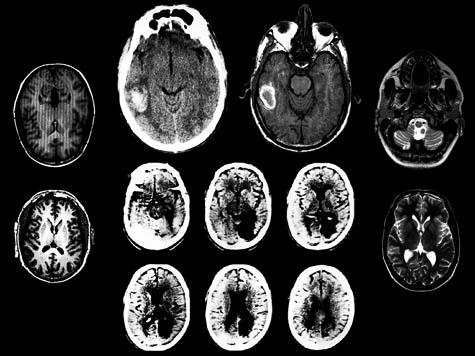Digital Memory Palace
First thing tomorrow morning, I will be presenting at Ruairi Glynn's Digital Architecture London conference, alongside Neil Spiller, Murray Fraser, and Alan Penn. Our topic is "Digital Architecture & Space."
Anticipating a day filled with formal discussions, I'll be speaking – albeit briefly – about what might be called the psychiatric effects of simulated environments. Specifically referring to the U.S. military's Virtual Iraq project, I want to bring into the discussion the idea that "digital space" can be used for therapeutic purposes.
 [Image: Brains].
[Image: Brains].
To quote at length from a fascinating article in The New Yorker about the use of virtual reality as a treatment for Post-Traumatic Stress Disorder:
Put another way, what if your renderings cured Post-Traumatic Stress Disorder?
With only a slight shift in emphasis, could you produce a building project that used the techniques of digital architecture to create an elaborate spatial memory system – a kind of RHINO mnemonics – that neurologically stimulated the act of remembering?
Of course, the use of architectural space as a road toward mental self-improvement, so to speak, is not at all new. A memory palace, for instance, is the art of remembering something by associating it with specific spatial details in a fantasy architectural structure, and this idea goes back at least to Cicero.
So is there a way to discuss the impact of digital design on architecture, with all of its implications of cinematic immersion and real-time animation, without getting stuck on questions of form? How might we discuss digital architecture's impacts on things like memory – and can we do so in the context of experimental psychiatry and so-called exposure therapy?
I should add that each speaker will only be presenting for about five minutes – so the above remarks will be quite short, before turning into a much more general panel discussion.
Anticipating a day filled with formal discussions, I'll be speaking – albeit briefly – about what might be called the psychiatric effects of simulated environments. Specifically referring to the U.S. military's Virtual Iraq project, I want to bring into the discussion the idea that "digital space" can be used for therapeutic purposes.
 [Image: Brains].
[Image: Brains].To quote at length from a fascinating article in The New Yorker about the use of virtual reality as a treatment for Post-Traumatic Stress Disorder:
- P.T.S.D. is precipitated by a terrifying event or situation—war, a car accident, rape, planes crashing into the World Trade Center—and is characterized by nightmares, flashbacks, and intrusive and uncontrollable thoughts, as well as by emotional detachment, numbness, jumpiness, anger, and avoidance. [A recently returned soldier from Iraq's] doctor prescribed medicine for his insomnia and encouraged him to seek out psychotherapy, telling him about an experimental treatment option called Virtual Iraq, in which patients worked through their combat trauma in a computer-simulated environment. The portal was a head-mounted display (a helmet with a pair of video goggles), earphones, a scent-producing machine, and a modified version of Full Spectrum Warrior, a popular video game.
Put another way, what if your renderings cured Post-Traumatic Stress Disorder?
With only a slight shift in emphasis, could you produce a building project that used the techniques of digital architecture to create an elaborate spatial memory system – a kind of RHINO mnemonics – that neurologically stimulated the act of remembering?
Of course, the use of architectural space as a road toward mental self-improvement, so to speak, is not at all new. A memory palace, for instance, is the art of remembering something by associating it with specific spatial details in a fantasy architectural structure, and this idea goes back at least to Cicero.
So is there a way to discuss the impact of digital design on architecture, with all of its implications of cinematic immersion and real-time animation, without getting stuck on questions of form? How might we discuss digital architecture's impacts on things like memory – and can we do so in the context of experimental psychiatry and so-called exposure therapy?
I should add that each speaker will only be presenting for about five minutes – so the above remarks will be quite short, before turning into a much more general panel discussion.





Comments are moderated.
If it's not spam, it will appear here shortly!
I hate to be all self-promo, but I have a talk called Paranoid Machines about the inherently paranoid nature of information architectures, beginning with the arts of memory and orbiting around the movie Tron. It seems relevant...
@superbunker
could you be more specific.?
On a related level there is a project being run by NPR that seeks to document the memory of places that no longer exist.
http://www.npr.org/templates/story/story.php?storyId=104211905
There could be an interesting application for digital and real architecture where memories are recreated in juxtaposition to each other creating places that feel familiar but don't necessarily match specific memories.
Just a thought.
@taemo
I'm afraid it's kind of a sprawling talk... But here's a summary and here's a video.
Geoff, thanks for this - I'd never heard or read of the "Method of Loci". I'm intrigued; the way you've described this, it sounds like it could have some clear application to militant sanctuary dynamics and practices.
@superbunker
haha really paranoid.
Post a Comment